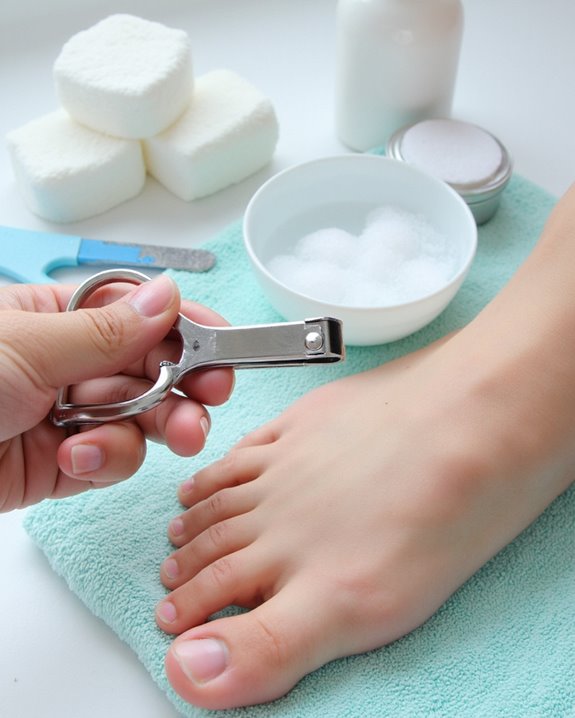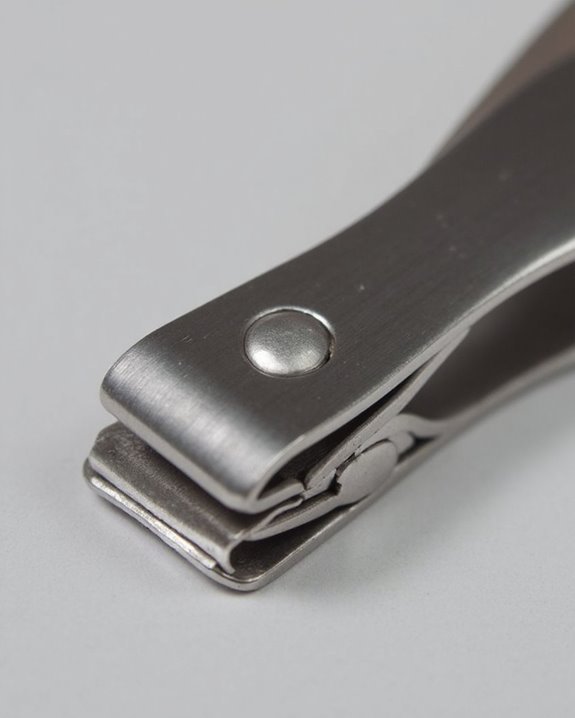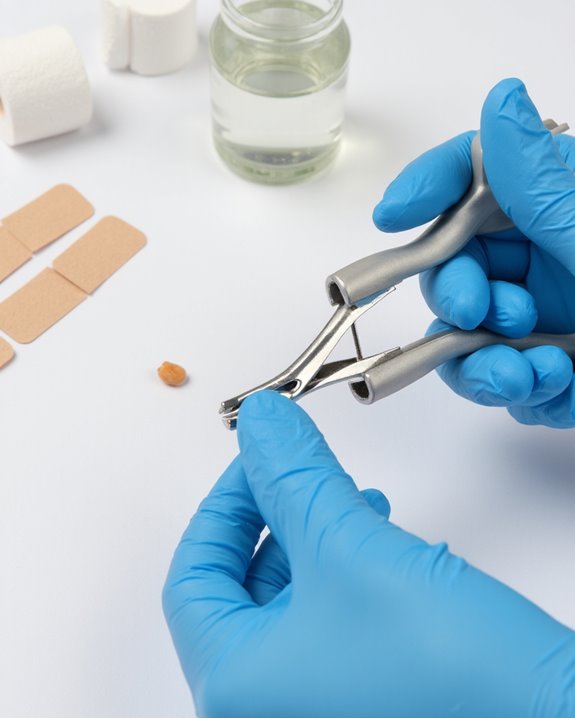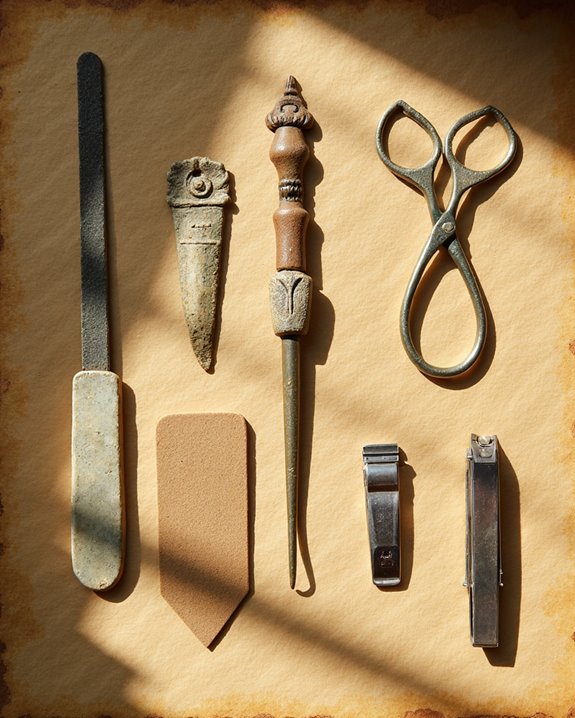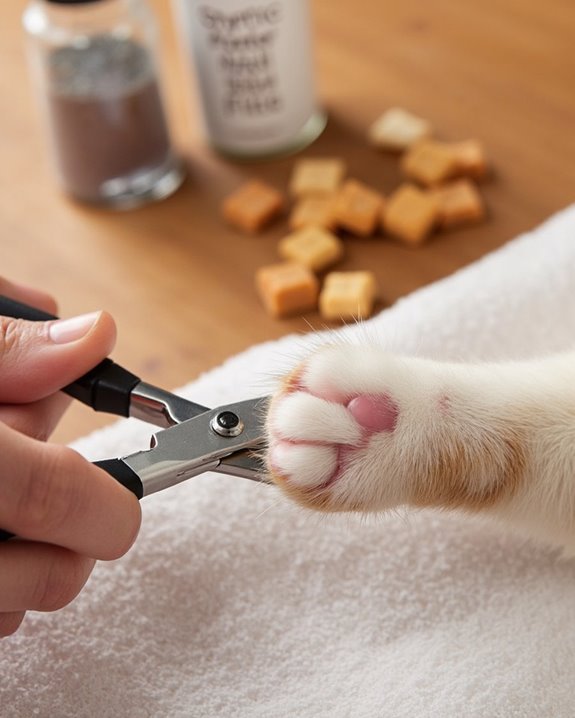To use toenail clippers effectively, I recommend these seven essential steps: select quality stainless steel clippers designed specifically for toenails, soak your feet in warm water for 10 minutes to soften nails, position yourself in a well-lit area with feet elevated, hold the clipper perpendicular to the nail, cut straight across to prevent ingrown toenails, file any rough edges in one direction, and disinfect your clippers with isopropyl alcohol after use. These techniques will transform your nail care routine for healthier feet.
Key Takeaways
- Select toenail-specific clippers with straight cutting edges and sharp stainless steel blades for clean, precise cuts.
- Soak feet in warm water for 10 minutes to soften nails before clipping for easier trimming.
- Position yourself in good lighting with foot elevated on opposite knee or stool for better visibility.
- Cut straight across the nail to prevent ingrown toenails, maintaining the clipper perpendicular to nail edges.
- File rough edges with an emery board immediately after cutting, then disinfect clippers with isopropyl alcohol.
Select the Right Toenail Clipper for Your Needs
Selecting the appropriate toenail clipper stands as the essential first step in proper nail care. I always recommend investing in toenail-specific clippers rather than generic nail clippers, as these essential tools are designed with the unique properties of toenails in mind. You’ll want to choose larger clippers with a straight cutting edge, which helps prevent ingrown nails and accommodates thicker toenails effectively.
When shopping for toenail clippers, I prioritize high-quality stainless steel models from reputable brands, as they provide clean, precise cuts without crushing or tearing the nail. The clipper should feel substantial in your hand, with sharp blades that require minimal pressure to operate. Remember, dull toenail clippers can cause uneven cuts and strain your hands, while quality tools with hygienic features will serve you reliably for years.
Prepare Your Feet Before Clipping
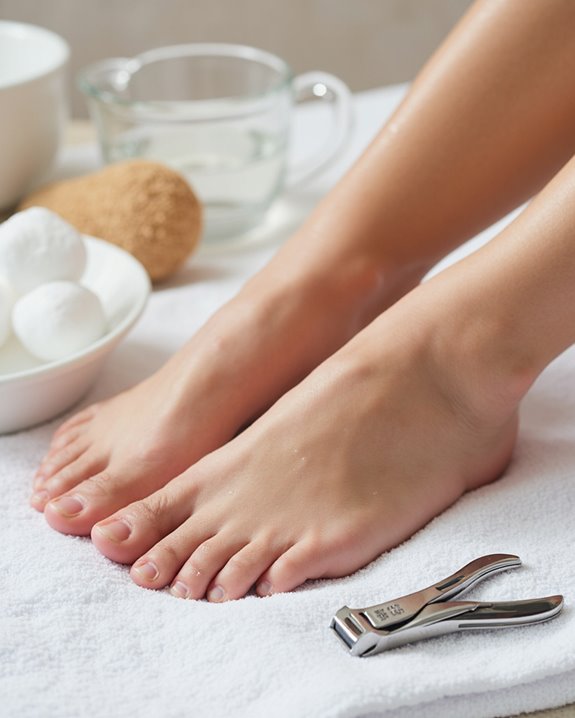
With the right clipper in hand, it’s time to prepare your feet properly before any trimming begins. I always start by thoroughly washing my feet with soap and water, which removes dirt and provides a clean surface to work with. This initial cleaning step helps me disinfect the area and clearly see what I’m doing.
Next, I soak my feet in warm, soapy water for about 10 minutes to soften my toenails, making them easier to clip without splitting. If my toenails feel particularly hard, I’ll extend the soaking time slightly. After soaking, I dry my feet completely to make sure I don’t slip while handling the clipper. I find this preparation works best immediately after a shower, when my toenails are naturally softer and more pliable.
Position Your Body and Feet Correctly
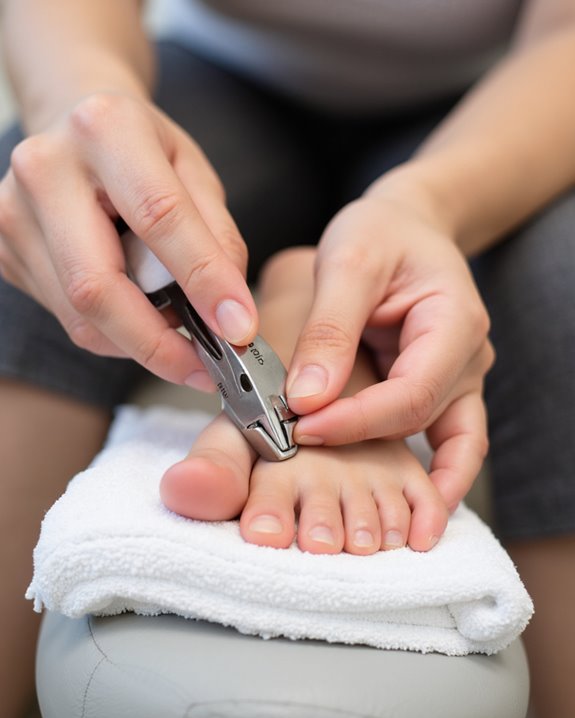
Proper positioning creates the foundation for safe, effective toenail clipping. Start by sitting in a stable chair with your back straight and feet flat on the floor, which gives you the stability needed when you hold the clippers. Place the foot you’re working on across your opposite knee or on a small stool, elevating it for better visibility.
Keep your body relaxed but aligned to prevent back strain, particularly important during longer grooming sessions. When you’re ready to cut straight, position the clipper perpendicular to your toenails straight across to reduce the risk of ingrown nails. Angle your foot toward good lighting so you can clearly see the nail’s edge and avoid cutting too deeply. This careful positioning guarantees precision and comfort throughout the entire clipping process.
Hold the Clipper With Proper Technique
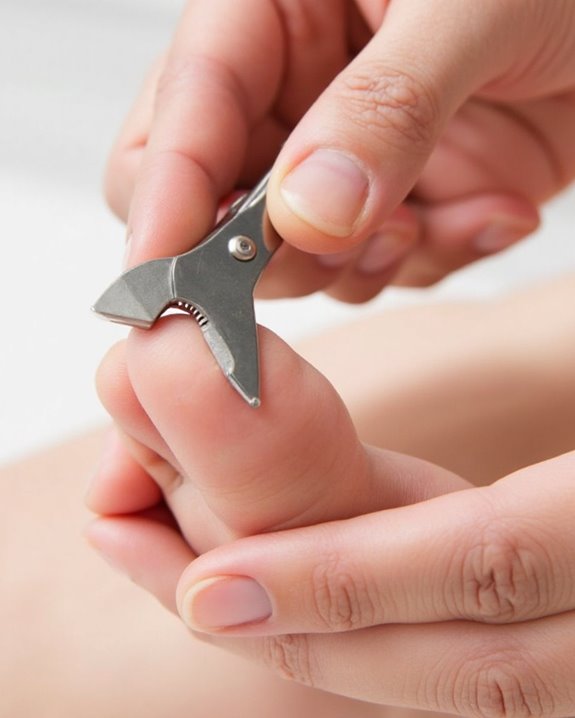
Now that you’ve established a stable position, it’s time to address how you’ll hold the tool that makes all the difference. I recommend gripping the toenail clipper firmly in your dominant hand, positioning your fingers securely around the handles to maintain control. This proper technique prevents slips that could lead to uneven cuts or skin injuries. Using a high-quality stainless steel cutter ensures durability and sharpness for clean, precise trimming. When you’re ready to clip, align the straight cutting edge parallel to your toenail, ensuring you’re using clippers specifically designed for toes rather than smaller fingernail versions. These larger tools provide better leverage and stability, reducing hand strain during the process. Open the clipper gently to accommodate your nail without applying excessive force, which helps maintain the tool’s functionality while minimizing fatigue. Remember, steady hands mean safer trimming, keeping the nail positioned precisely between the blades.
Cut Straight Across to Prevent Ingrown Toenails
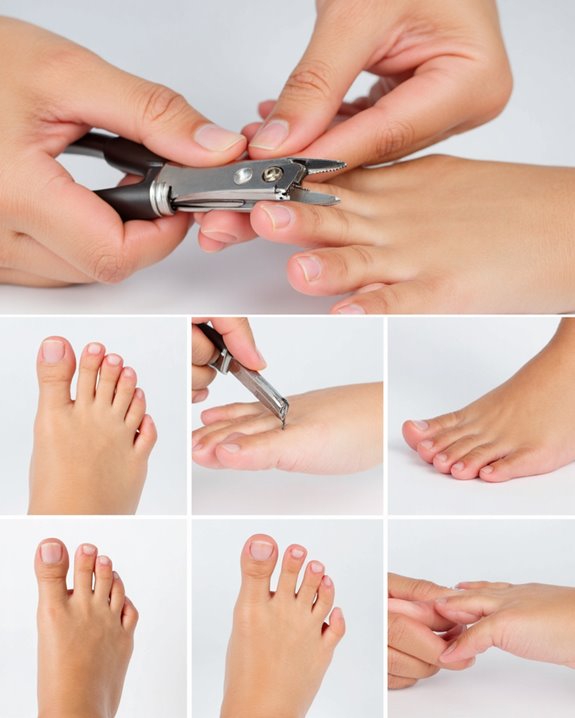
Cutting straight across your toenail stands as the single most important technique for preventing painful ingrown nails, which occur when the edge of your nail grows into the surrounding skin. When you cut your nails, position the clipper to create a clean, horizontal line just beyond the toe’s end, maintaining the nail’s natural shape rather than curving the edges inward.
This nail trimming method greatly reduces ingrown toenail risk—by up to 50% according to podiatry research—because it keeps the nail edges flush with your toe instead of allowing them to embed into surrounding tissue. I’ve found that patients who adopt this straight-cutting technique consistently experience fewer complications requiring professional intervention. Make this approach a regular part of your foot care routine to maintain healthy toenails and avoid the discomfort of infections.
File Rough Edges After Clipping
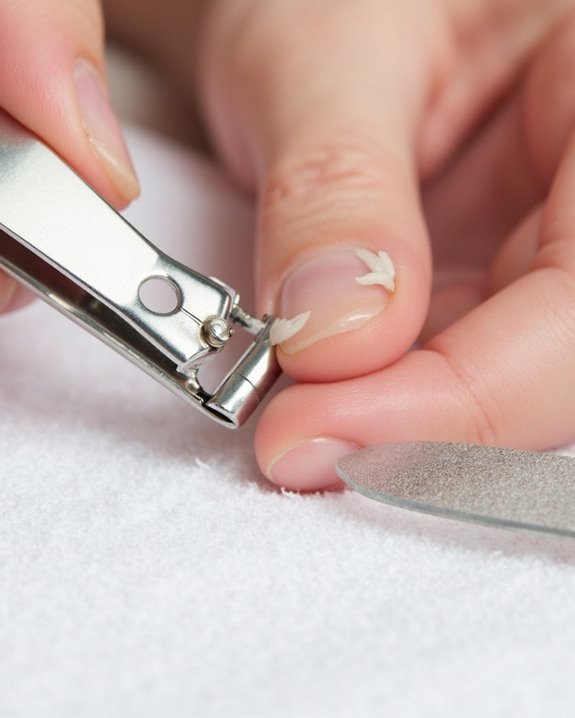
Once you’ve finished the initial clipping of your toenails, smoothing any rough edges becomes a critical next step that many people unfortunately overlook. I recommend using a fine-grit emery board specifically designed for toenails to prevent snagging, chipping, and potential discomfort from jagged edges. Using a semi-fine grit nail file helps achieve a smooth, polished finish without damaging the nail surface. Always file in one direction along the nail’s edge, never using a back-and-forth sawing motion, as this can weaken your nail structure and lead to splitting. I’ve found that applying gentle, consistent pressure with light strokes works best for achieving a polished finish. This immediate filing after trimming eliminates hazards like nails catching on socks or bedding, while supporting long-term nail integrity. Your toenails will not only look better but remain stronger and healthier when you incorporate this essential step.
Clean and Disinfect Your Clippers After Use

After you’ve smoothed those rough nail edges, proper hygiene demands attention to your tools. I always wipe my clippers with a dry cloth immediately after use, removing any nail debris that could harbor bacteria. Proper care is essential to prevent contamination between uses.
To thoroughly disinfect your tools, I recommend using 70-90% isopropyl alcohol, which effectively kills most harmful microorganisms and reduces the risk of infections. Simply scrub the blades with alcohol for at least 30 seconds, ensuring all surfaces make contact with the disinfectant. Afterward, rinse with clean water and dry completely—any lingering moisture can encourage bacterial growth.
This cleaning routine might seem meticulous, but consistent disinfection prevents the transfer of pathogens that could lead to fungal or bacterial complications.
Frequently Asked Questions
What Is the Proper Way to Use Toenail Clippers?
As easy as pie, I use large straight-edge toenail clippers and cut straight across. I soak my feet first, then trim big toe to pinky. Clipper maintenance includes tool sterilization with alcohol. These technique tips prevent ingrown nails.
What Is the Easiest Way for Seniors to Cut Toenails?
If you have arthritis, I’d recommend soaking your feet first for relief. Use visual aids like magnifiers in good lighting. For balance support, sit comfortably with your foot on a stable surface while trimming.
Is It Better to Clip Toenails Wet or Dry?
You might wonder… what’s the secret to painless nail care? I’ve found wet clipping benefits outweigh dry nail hygiene practices. The moisture versus texture difference is significant—soak your toenails before trimming for softer, less brittle cuts.
How to Remove an Ingrown Toenail Yourself With Clippers?
I’d caution against self-removal of ingrown toenails due to Ingrown Risks like infection. Instead, try Pain Relief soaks and proper trimming techniques. If symptoms persist, professional Healing Methods are safer than DIY clipping.

